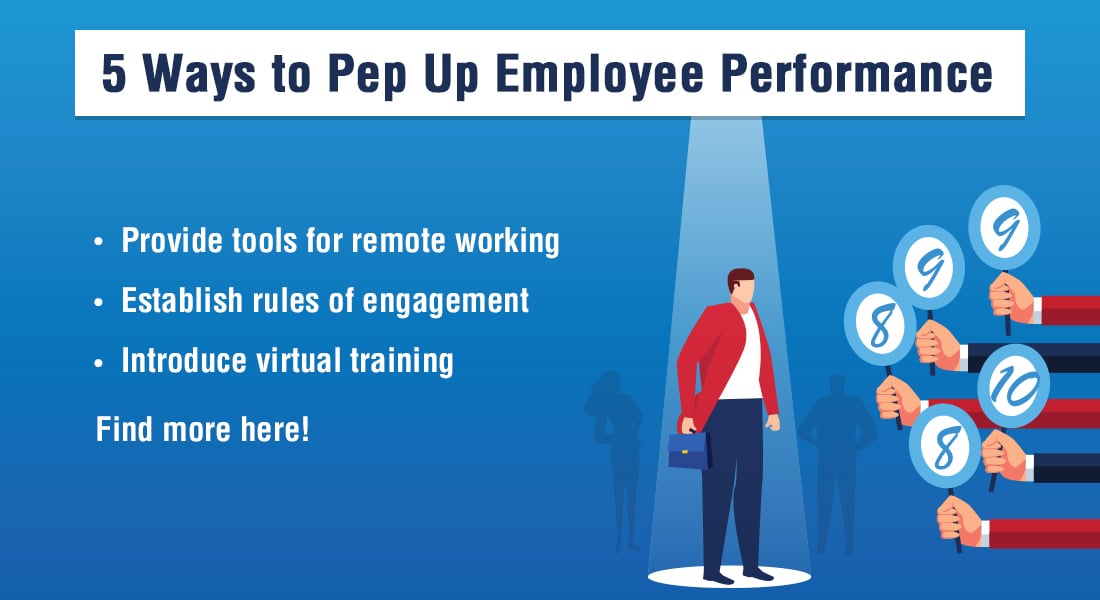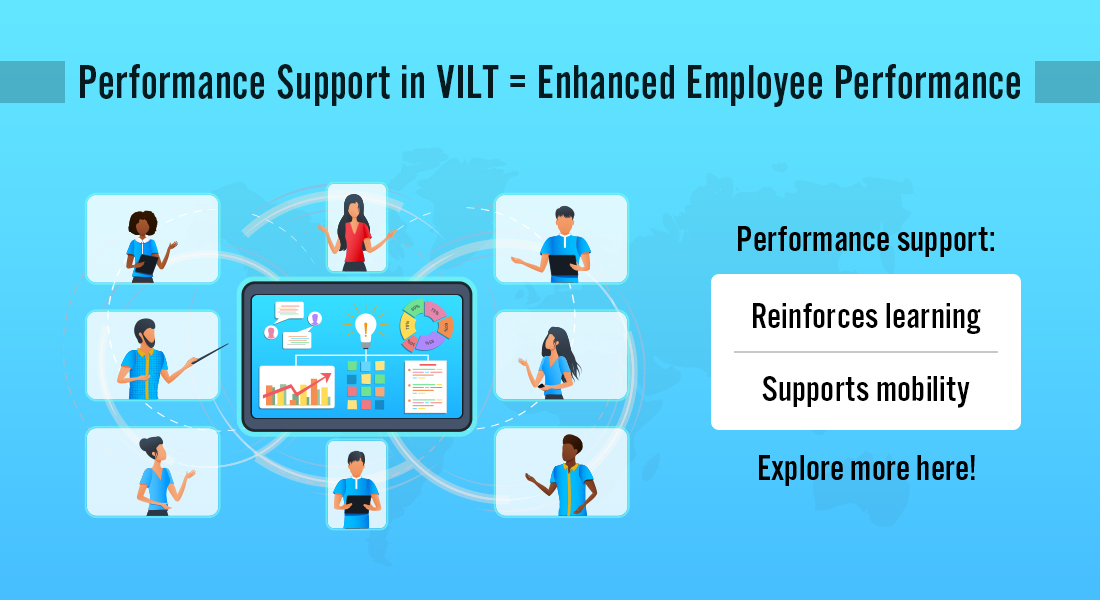Navigating the COVID-19 Crisis: 5 Ways to Enhance Employee Performance

According to a 2019 research report by the World Economic Forum, less than 10% of business leaders from G20 and OECD considered infectious diseases as a threat to the global business market. Yet, one year later, here we are! The COVID-19 pandemic brought us many things – travel ban, social distancing, lockdown, home quarantine, and of course, the work from home policy. All this has drastically affected the business world and many organizations are still navigating a sink or swim situation. To stay afloat, businesses need to focus on employee performance and productivity, now more than ever. But that is easier said than done.
How to Boost Employee Performance during the COVID-19 Crisis
- Provide tools and infrastructure to facilitate remote working
- Establish rules of engagement
- Introduce virtual training
- Acknowledge employees’ efforts and achievements
- Provide social, mental, and healthcare support
But first, let’s get one thing straight lest we forget it. Your ‘at-home workers’ are not only working from home, they are doing that during a pandemic. They might be taking zoom calls from their kitchen countertops while trying to work through their own health-related anxieties and trying to adapt to new routines.
It is extremely important for you to take measures to safeguard and support your employees to the best of your abilities. You can be assured of effective employee performance only when they are secure in their own situation, both at home and at work (since those lines are very blurred right now).
How can you do that?
Well, here are some ideas that will not only help you navigate through these business disruptions but also ensure continued effective employee performance.
How to Ensure Effective Employee Performance with the Work-from-home Workforce
1. Provide Tools and Infrastructure to Facilitate Remote Working
Remote working is not a new concept, but before the last few months, it was an option available for only a few. Since most businesses were forced to implement the work from home policy, the number of remote workers across the world has doubled, almost overnight.
In US alone, the number of employees working from home has more than doubled from mid-March to mid-May, from 31% to 65%, accounting for more than 100 million workers. As the situation stands, most of these accidental remote workers don’t have the infrastructure available for working from home.
So, your first step should be to ensure that all employees have access to the required tools and software that will facilitate seamless workflow. Here are a few things you can do:
- Ensure employees have uninterrupted Internet and secure VPN access to carry out their job responsibilities virtually without any disruptions or security threats. You can also take measures to pay for such facilities if employees are not able to.
- Provide employees with desktops, laptops, mobile devices, or any other hardware they need.
- Buy licensing for any digital tool or software needed by employees and provide individual access to them.
- Set up proper digital communication channels like Microsoft Teams, Skype, Zoom, etc., for daily meetings and platforms like PM tools to keep track of all work.
2. Establish Rules of Engagement
Even before the present situation, employee performance was being hampered by employee distraction and disengagement. Now that employees are working from home, you can be sure they are going to be even more distracted. You can’t blame them for that; after all, working from home doesn’t provide the space and isolation needed to focus on work. Instead, you can set up clear rules of engagement that employees need to follow to create some semblance of workplace order in their homes.
- Ask employees to set up their workstation away from the space usually occupied by their families.
- Set up daily meetings and calls at the start of the workday to fix targets, and at the end to ensure that the set targets are met.
- Ask employees to follow a strict work timeline, virtually punching-in and out as they did at the office.
- Reinforce organizational values and policies to prevent misconduct that can result from lack of direct supervision.
3. Introduce Virtual Training for Uninterrupted Learning
One of the most affected areas in this whole situation is perhaps corporate L&D. For years, organizations have relied a great deal on physical classrooms and instructor-led training (ILT) for their workforce training. Even with the advent of eLearning, classroom ILT still played a major role in corporate training. Since training is such an important factor for employee performance, skill enhancement and productivity, organizations are now forced to shift from ILT to virtual training.
Here are a few virtual training methods you can implement to ensure that your organizational training initiatives are uninterrupted and successful.
- Shift all your classroom and offline training materials to digital formats. You can do that by converting your ILT material to eLearning and by going for rapid eLearning development.
- Use virtual classrooms or virtual instructor-led training sessions to conduct face-to-face virtual training sessions.
- Create an online library of microlearning assets in various formats such as videos, audio podcasts, quizzes, interactive PDFs, and blogs that learners can access with ease.
- Make use of new-age learning practices like mobile learning and social learning to facilitate remote learning.
4. Acknowledge Employees’ Efforts and Achievements
Genuine appreciation goes a long way in garnering employee motivation. Now that most of them are working in an uncertain reality, acknowledging their work and efforts will not only encourage them but also serve as a strong incentive for other employees to change their behavior.
You can use monetary rewards, public appreciation, tokens of appreciation, and many other ways to recognize employees. Acknowledging them for their efforts and achievements will serve to positively impact employee performance.
5. Provide Social, Mental, and Healthcare Support
As I mentioned before, while you may find these work-related challenges overwhelming, you cannot and should not forget the bigger and scarier picture – COVID-19. Your employees’ social, mental, and physical wellbeing comes before anything else. After all, being mentally and physically healthy is the first step toward optimizing employee performance.
Here are a few measures you can take to ensure that your employees are well taken care of.
- Issue guidelines about precautionary and preventive measures against COVID-19. Include healthcare and hygiene tips for employees to follow. Also, list out the general symptoms and first-response tactics in case they show signs of infection.
- Establish regular communication, both formal and informal, to ensure your employees do not feel isolated and alone during these difficult times. You can also promote mental health awareness and provide them with professional help and intervention if needed.
- Provide paid leaves and healthcare incentives to those employees who are sick whether because of the virus or not.
- Take measures to prevent stigmatizing employees who are sick because of Coronavirus or are in a vulnerable state because of mental health issues.
- Prevent the spread of fake information and prejudiced and hateful messages that can add to the already mounting tension.
Summing it Up!
We are living in times when the challenges we face are as unprecedented as they are unpredictable. But situations like these are what test your mettle as a leader and manager. This 5-point list of measures will help you enhance employee performance not only for the time being, but also in the long run. Balance your focus between business goals and employee welfare and you will soon emerge as an effective and successful leader.
If you are interested in maximizing the benefits of virtual classrooms for corporate training during these times, download our eBook.





